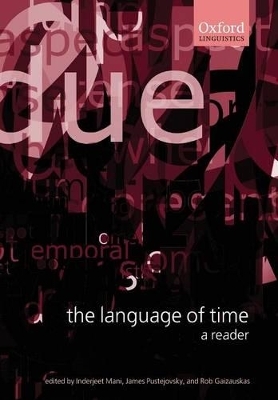
The Language of Time: A Reader
Oxford University Press (Verlag)
978-0-19-926854-2 (ISBN)
This reader collects and introduces important work in linguistics, computer science, artificial intelligence, and computational linguistics on the use of linguistic devices in natural languages to situate events in time: whether they are past, present, or future; whether they are real or hypothetical; when an event might have occurred, and how long it could have lasted. In focussing on the treatment and retrieval of time-based information it seeks to lay the foundation for temporally-aware natural language computer processing systems, for example those that process documents on the worldwide web to answer questions or produce summaries. The development of such systems requires the application of technical knowledge from many different disciplines. The book is the first to bring these disciplines together, by means of classic and contemporary papers in four areas: tense, aspect, and event structure; temporal reasoning; the temporal structure of natural language discourse; and temporal annotation. Clear, self-contained editorial introductions to each area provide the necessary technical background for the non-specialist, explaining the underlying connections across disciplines.
A wide range of students and professionals in academia and industry will value this book as an introduction and guide to a new and vital technology. The former include researchers, students, and teachers of natural language processing, linguistics, artificial intelligence, computational linguistics, computer science, information retrieval (including the growing speciality of question-answering), library sciences, human-computer interaction, and cognitive science. Those in industry include corporate managers and researchers, software product developers, and engineers in information-intensive companies, such as on-line database and web-service providers.
Inderjeet Mani is Associate Professor of Linguistics at Georgetown University, where he chairs the program in Computational Linguistics. He works on the computer understanding of temporal narrative and on ontologies for natural language processing. His work on automatic summarization has included new summarization methods as well as evaluation techniques, while his research on temporal information extraction has led to the development of taggers for temporal expressions in various languages. He has served on the Editorial Board of the journal Computational Linguistics (2002-4), and has published more than fifty scientific papers and two books: Automatic Summarization (2001) and the co-edited volume Advances in Automatic Text Summarization (1999). James Pustejovsky is Professor of Computer Science and Director of the Laboratory for Linguistics and Computation at Brandeis University. His research focuses on the areas of computational and theoretical models of lexical semantics, temporal reasoning, knowledge representation, and information extraction and retrieval in bioinformatics. His books include The Generative Lexicon (1995), Meaning in Context (2005), and the edited volumes Lexical Semantics and Knowledge Representation (1992 with Sabine Bergler), Semantics and the Lexicon (1993); Lexical Semantics and the Problem of Polysemy (1997 with Bran Boguraev), and Events as Grammatical Objects (2000 with Carol Tenny). Robert Gaizauskas is Professor of Computer Science at the University of Sheffield. His research interests lie in applied natural language processing, especially information extraction and retrieval, both from newswire text and from scientific writing, particularly medical and biological text. He also works on automatic question answering and summarization, on the extraction of temporal information from texts and has an on-going interest in evaluation of language technology. He has published over 80 papers in peer-reviewed journals and conference proceedings.
PART 1: TENSE, ASPECT, AND EVENT STRUCTURE ; 1. Verbs and Times ; 2. The Syntax of Event Structure ; 3. The Algebra of Events ; 4. The Tense of Verbs ; 5. Tense Logic and the Logic of Earlier and Later ; 6. Temporal Ontology and Temporal Reference ; 7. Deriving Verbal and Compositional Lexical Aspect for NLP Applications ; 8. A Computational Model of the Semantics of Tense and Aspect ; PART II: TEMPORAL REASONING ; 9. A Temporal Logic for Reasoning About Processes and Plans ; 10. A Logic-Based Calculus of Events ; 11. Extending the Event Calculus with Temporal Granularity and Indeterminacy ; 12. Towards a General Theory of Action and Time ; 13. A Critical Examination of Allen's Theory of Action and Time ; 14. Annotating and Reasoning About Time and Events ; PART III: TEMPORAL STRUCTURE OF DISCOURSE ; 15. The Effects of Aspectual Class on the Temporal Structure of Discourse: Semantics or Pragmatics? ; 16. Temporal Relations, Discourse Structure, and Commonsense Entailment ; 17. News Stories as Narratives ; 18. Tense as Discourse Anaphor ; 19. Tense Interpretation in the Context of Narrative ; 20. An Empirical Approach to Temporal Reference Resolution ; 21. Tense Trees as the Fine Structure of Discourse ; 22. Algorithms for Analyzing the Temporal Structure of Discourse ; PART IV: TEMPORAL ANNOTATION ; 23. A Multilingual Approach to Annotating and Extracting Temporal Information ; 24. The Annotation of Temporal Information in Natural Language Sentences ; 25. Assigning Time-Stamps to Event-Clauses ; 26. From Temporal Expressions to Temporal Information: Semantic Tagging of News Messages ; 27. The Specification Language TimeML ; 28. A Model for Processing Temporal References in Chinese ; 29. Using Semantic Inference for Temporal Annotation Comparison ; Index
| Erscheint lt. Verlag | 26.5.2005 |
|---|---|
| Zusatzinfo | Numerous figures |
| Verlagsort | Oxford |
| Sprache | englisch |
| Maße | 171 x 245 mm |
| Gewicht | 1053 g |
| Themenwelt | Geisteswissenschaften ► Psychologie ► Verhaltenstherapie |
| Geisteswissenschaften ► Sprach- / Literaturwissenschaft ► Sprachwissenschaft | |
| Informatik ► Software Entwicklung ► User Interfaces (HCI) | |
| Sozialwissenschaften ► Kommunikation / Medien ► Buchhandel / Bibliothekswesen | |
| ISBN-10 | 0-19-926854-1 / 0199268541 |
| ISBN-13 | 978-0-19-926854-2 / 9780199268542 |
| Zustand | Neuware |
| Haben Sie eine Frage zum Produkt? |
aus dem Bereich


